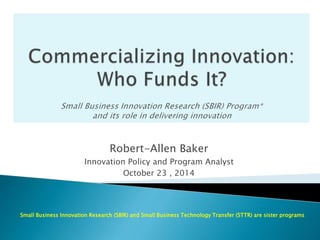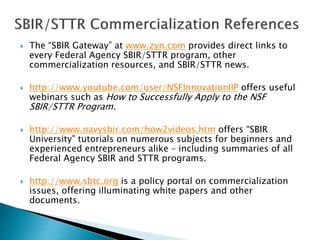Funding American Innovation: SBIR/STTR Explained
- 1. Robert-Allen Baker Innovation Policy and Program Analyst October 23 , 2014 Small Business Innovation Research (SBIR) and Small Business Technology Transfer (STTR) are sister programs
- 2. ’üĮ From 15 USC 638 (e)(10) ŌĆō the SBIR/STTR statute ŌŚ” the term "commercialization" means-- (A) the process of developing products, processes, technologies, or services; and (B) the production and delivery (whether by the originating party or by others) of products, processes, technologies, or services for sale to or use by the Federal Government or commercial markets ’üĮ Federal Agency commercialization metrics: ŌŚ” Transition results in sale or license of a technology product or process ŌŚ” Commercialization revenues exceed SBIR/STTR investment ŌŚ” Technology product or process advances mission of the Agency to benefit society
- 4. Discovery Phase I Phase II Phase III Proof-of Concept SBIR Product Design Product Development Manufacturing/ Delivery Idea Pre-seed Funding Seed Funding Expansion/Mezzanine Operating Cap. Friends and Family Angels Venture Funds Start-up Funding Seed Funds Founder Institutional Equity Loans / Bonds Angel Groups
- 5. Angels Provide ~90% of Outside Equity for Startups Angel Investors (2014) ŌĆó $24.8 billion ŌĆó 70, 730 deals ŌĆó 23,460 seed (2012) ŌĆó 22,129 early stage ŌĆó 21,441 expansion ŌĆó > 268,000 individuals Venture Capital (2014) ŌĆó $20.7 billion ŌĆó 2,099 deals ŌĆó 280 seed (2012) ŌĆó 1,647 early stage ŌĆó 1,796 later/expansion ŌĆó 522 active firms Sources: Center for Venture Research/ UNH; NVCA 2013 Yearbook; PwC MoneyTree
- 6. $1.50 $1.00 $0.50 $0.00 $980K 2010 2011 2012 Median Round Size Mean Round Size 6 *Angel rounds include angels & angel groups only $900K $990K $500K $625K $600K $M
- 7. ’üĮ Congressional passion for small business innovation dates to the passage of an SBIR statute in 1983, followed by STTR in 1992. ’üĮ SBIR/STTR reauthorization in 2011 focused on the importance of commercializing technology, delivering innovation to customers. ’üĮ At ~$2.3B, SBIR/STTR is the largest Federal program available to help small business inventors negotiate the innovation ecosystem -- >145,000 awards since 1985, averaging 10 patents/day. ’üĮ For innovation investors, SBIR/STTR ris non-diluted funding used to reduce risk, accelerate technology, and preserve your IP rights. ’üĮ The Fall National SBIR/STTR Conference in Austin on Nov. 11 -13 is the entry way into SBIR/STTR for entrepreneurs.
- 8. ’üĮ PHASE I ’é¦ Feasibility Study ’é¦ ~$150K six-month award (SBIR) ’é¦ ~$150K up to 12-months (STTR) ŌĆó PHASE II ’é¦ Full research to prototype ’é¦ $1M+ via two-year award ŌĆó PHASE III - Goal of Program ’é¦ Commercialization stage ’é¦ Funded with non-SBIR/STTR $ ’é¦ Can be funded by the Agency or Private Sector or both 8
- 9. 9
- 11. NASA Phase II supplements:
- 12. 12 % of Phase I Awardees 35% 30% 25% 20% 15% 10% 5% 0% 2009 2010 2011 2012 First time DOE winners First-time DOE applicants
- 14. ’üĮ Free, continuous support by skilled entrepreneurial support providers accompanies most SBIR/STTR awards: ŌŚ” Phase I assistance ’é¢ Commercialization readiness assessment ’é¢ Focused assistance with development of Phase II commercialization plans ŌŚ” Phase II assistance ’é¢ Flexible offerings to meet a variety of commercialization needs in DoD Agencies and Civilian Agencies alike ’é¢ Market research on customers ’é¢ Investor introductions ’üĮ Company-selected commercialization assistance vendor ŌŚ” Reauthorization permits companies to select their own vendors to provide $5K/year commercialization assistance in Phases I and II. ŌŚ” Company must include this vendor as a subcontractor or consultant in their Phase I or II application
- 15. What requirements does a RIF project satisfy? ’üĮ Satisfy an operational or national security need: ŌŚ” Accelerate or enhance military capability ŌŚ” In support of major defense acquisition program ’üĮ Reduce: ŌŚ” Technical risk ŌŚ” Cost: Development, acquisition, sustainment, or lifecycle ’üĮ Completed within 24 months of award ’üĮ Cost is not more than $3 million Selection Preference to Small Business Proposals
- 17. ’üĮ As an inventor, your priority must be to identify customers for a technology adapted by you to meet their needs and requirements. ’üĮ As an SBIR/STTR awardee, your priorities must be to: ŌŚ” ŌĆ” help fulfill the mission of your funding Agency. ŌŚ” ŌĆ” leverage non-SBIR/STTR resources to mature your technology and productize it for potential customers youŌĆÖve identified. ’üĮ As a small business principal, your priority must be to fairly appraise your strengths and weaknesses, and build a team that allows you to aggressively market your invention. ’üĮ And yes, we ARE here to help ŌĆ”ŌĆ”
- 18. ’üĮ The ŌĆ£SBIR GatewayŌĆØ at www.zyn.com provides direct links to every Federal Agency SBIR/STTR program, other commercialization resources, and SBIR/STTR news. ’üĮ http://www.youtube.com/user/NSFInnovationIIP offers useful webinars such as How to Successfully Apply to the NSF SBIR/STTR Program. ’üĮ http://www.navysbir.com/how2videos.htm offers ŌĆ£SBIR UniversityŌĆØ tutorials on numerous subjects for beginners and experienced entrepreneurs alike ŌĆō including summaries of all Federal Agency SBIR and STTR programs. ’üĮ http://www.sbtc.org is a policy portal on commercialization issues, offering illuminating white papers and other documents.
- 19. Questions?



















